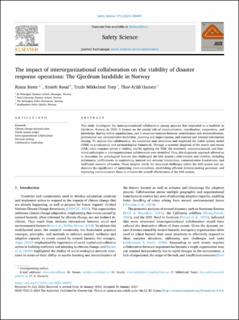The impact of interorganizational collaboration on the viability of disaster response operations: The Gjerdrum landslide in Norway
Journal article, Peer reviewed
Published version
Permanent lenke
https://hdl.handle.net/11250/3123148Utgivelsesdato
2024Metadata
Vis full innførselSamlinger
Originalversjon
10.1016/j.ssci.2024.106459Sammendrag
This study investigates the interorganizational collaboration among agencies that responded to a landslide in Gjerdrum, Norway in 2020. It focuses on the crucial role of communication, coordination, cooperation, and knowledge sharing within organizations, and it examines tensions between centralization and decentralization, professional and administrative leadership, planning and improvisation, and external and internal information sharing. To explore this collaboration, we conducted nine interviews and employed the viable system model (VSM) as a conceptual and methodological framework. Through a systemic diagnosis of the search and rescue (SAR) crisis response system’s viability and by applying the VSM, the structural, communicational, and functional pathologies in interorganizational collaboration were identified. Thus, this diagnostic approach allowed us to determine the pathological features that challenged the SAR system’s effectiveness and viability, including imbalances, inefficiencies in maintaining internal and external interactions, communication breakdowns, and inefficient resource allocation. These insights clarify the structural challenges within the SAR system and underscore the significance of optimizing interconnections, establishing efficient decision-making processes, and improving communication flows to enhance the overall effectiveness of the SAR system.

